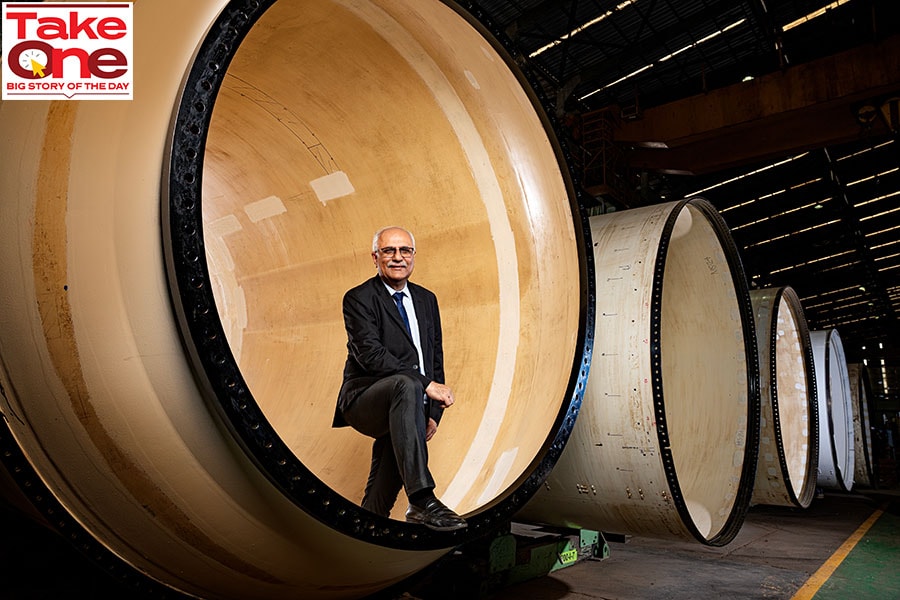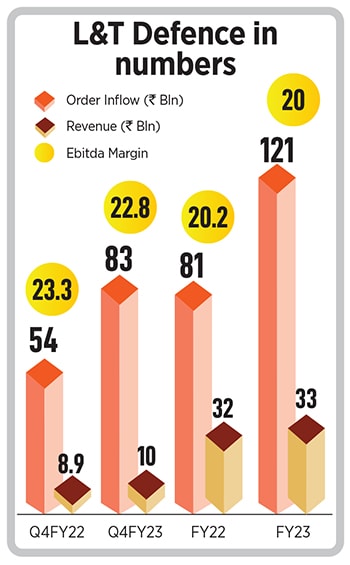
Decoding L&T's defence blueprint
With its Industry 4.0, digitalisation and shipbuilding capabilities, the defence arm of the engineering major has been growing its order book across land, sea and air, making everything from tanks and radars to cadet ships and multi-purpose vessels
 Arun Ramchandani, executive vice president and head, L&T Defence. Image: Mexy Xavier
Arun Ramchandani, executive vice president and head, L&T Defence. Image: Mexy Xavier
It was around three years ago that the idea of a light tank germinated at L&T Defence. The defence arm of the engineering and construction major had been working on the Vajra K9 howitzers for the Indian Army; the need for equipment at high altitudes like in Ladakh and the Sino-India border was the driver for such a product. L&T Defence teamed up with the Defence Research and Development Organisation (DRDO), which was also looking at a light tank, to develop it. After co-designing the 25-tonne light tank, the DRDO in 2022 placed an order with L&T as a development-cum-production partner to build the first prototype.
“Main battle tanks like Arjun typically weigh 60 tonnes and carry high calibre cannons. If you want to move in high altitude areas or operate in sand dunes, you need a more agile and lighter armoured vehicle,” says Arun T Ramchandani, who took over as executive vice president & head, L&T Defence, last year. “So we are talking about a tank in the ballpark of 25 to 30 tonnes as opposed to 60 to 70 tonnes, to an extent of the same family but different in terms of pretty much how a large SUV is different from a compact SUV.”
The prototype, being built at L&T’s Armoured Systems Complex at Hazira in Gujarat, is at an advanced stage. “We should shortly be ready for trials and demonstrating it to the Army,” says Ramchandani.
According to an Acceptance of Necessity (AoN), or in-principle agreement for acquisition, the Ministry of Defence’s (MoD) Acquisition Council (DAC) greenlit six light tank regiments, each equipped with 59 tanks. The AoN specifies that L&T, as development-cum-production partner to DRDO, will build one regiment of light tanks, while the MoD acquires the balance five regiments under the government’s ‘Make’ procedure for which L&T will compete with other industry players.
In the bigger scheme of things at L&T, L&T Defence is a small part of the whole—bringing in 2 to 3 percent of the total group revenues in the projects and manufacturing segment. But within the private sector in defence in India, it is one of the major players with a gamut of offerings covering everything from ships and submarines to land combat vehicles, radar systems and PSLV rockets; the light tank is just one of several projects and contracts the company currently has under its belt.



 In March, the MoD also signed a contract with L&T for the procurement of three cadet ships worth Rs3,100 crore under the Buy (Indian-IDDM) category, which essentially means procurement of products from an Indian vendor that have been indigenously designed, developed and manufactured with a minimum of 50 percent Indigenous Content (IC) on cost basis of the total contract value.
In March, the MoD also signed a contract with L&T for the procurement of three cadet ships worth Rs3,100 crore under the Buy (Indian-IDDM) category, which essentially means procurement of products from an Indian vendor that have been indigenously designed, developed and manufactured with a minimum of 50 percent Indigenous Content (IC) on cost basis of the total contract value. 















